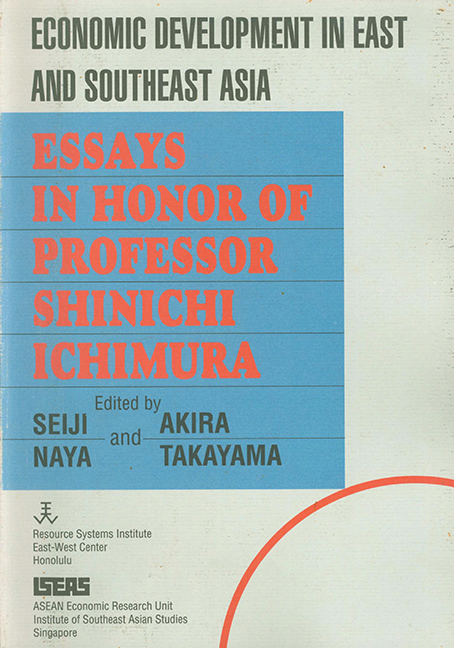Book contents
- Frontmatter
- Preface
- Shinichi Ichimura, 1925-
- CONTENTS
- Introduction
- Contributors to This Volume
- I Structural Change and Economic Development in Developing Asia in the 1990s
- II Explaining the Success of the Four Little Dragons: A Survey
- III Taiwan's Economic Miracle: A Singaporean Perspective
- IV Singapore's Experience of Industrial Restructuring: Lessons for the Other Asian NIEs
- V Korean Industrial Policies for Declining Industries
- VI Vietnam: Recent Economic Developments and the World Economy
- VII Transition from Import Substitution to Export Expansion: The Thai Experience
- VIII Adjustment Problems of a Small Oil-Exporting Country: Did Indonesia Suffer from the Dutch Disease?
- IX A Quarterly Econometric Model of the Hong Kong Economy
- X The Effect ofRicardian Rent Extracting on Macroeconomic Performance
- XI Direct Foreign Investment and the Economic Development of Korea
- XII Japanese Investment in Thailand: Looking Back and Into the Future
- XIII The Effects of Direct Foreign Investment on Taiwan: A Macroeconometric Investigation
- XIV A Reform of the Foward Foreign Exchange Market and Foreign Exchange Rate Determination Policy in Korea, with Foreign Exchange Policy Experiences of Taiwan
- XV Interest Rate and Foreign Exchange Liberalization in Taiwan in the 1980
- XVI Manifold Dilemmas behind External Debt Management
- XVII Agricultural Growth and Food Imports in Developing Countries: A Reexamination
- XVIII The Transformation of Rural Asia and Economic Development Theory and Policy
- XIX The ASEAN Summit and ASEAN Economic Cooperation
- XX The Role of Developing Countries in the New GATT Round
- XXI The Emerging Global Economy and the Role of the Asian NIEs
- Index
XV - Interest Rate and Foreign Exchange Liberalization in Taiwan in the 1980
Published online by Cambridge University Press: 21 October 2015
- Frontmatter
- Preface
- Shinichi Ichimura, 1925-
- CONTENTS
- Introduction
- Contributors to This Volume
- I Structural Change and Economic Development in Developing Asia in the 1990s
- II Explaining the Success of the Four Little Dragons: A Survey
- III Taiwan's Economic Miracle: A Singaporean Perspective
- IV Singapore's Experience of Industrial Restructuring: Lessons for the Other Asian NIEs
- V Korean Industrial Policies for Declining Industries
- VI Vietnam: Recent Economic Developments and the World Economy
- VII Transition from Import Substitution to Export Expansion: The Thai Experience
- VIII Adjustment Problems of a Small Oil-Exporting Country: Did Indonesia Suffer from the Dutch Disease?
- IX A Quarterly Econometric Model of the Hong Kong Economy
- X The Effect ofRicardian Rent Extracting on Macroeconomic Performance
- XI Direct Foreign Investment and the Economic Development of Korea
- XII Japanese Investment in Thailand: Looking Back and Into the Future
- XIII The Effects of Direct Foreign Investment on Taiwan: A Macroeconometric Investigation
- XIV A Reform of the Foward Foreign Exchange Market and Foreign Exchange Rate Determination Policy in Korea, with Foreign Exchange Policy Experiences of Taiwan
- XV Interest Rate and Foreign Exchange Liberalization in Taiwan in the 1980
- XVI Manifold Dilemmas behind External Debt Management
- XVII Agricultural Growth and Food Imports in Developing Countries: A Reexamination
- XVIII The Transformation of Rural Asia and Economic Development Theory and Policy
- XIX The ASEAN Summit and ASEAN Economic Cooperation
- XX The Role of Developing Countries in the New GATT Round
- XXI The Emerging Global Economy and the Role of the Asian NIEs
- Index
Summary
Introduction
Taiwan's economic liberalization over the past three decades has been relatively smooth and gradual, and seems to have been the result of careful implementation under a variety of constraints. But some markets, including the financial market, remained subject to substantial controls up until the end of the 1970s.
Starting in the early 1980s, there -was an increasing demand for adjustment to new circumstances, and liberalization and internationalization were adopted as basic national policies. In line with this policy, the government has been taking measures to loosen the tight controls over the banking system. Interest rate and foreign exchange liberalization was the first major step in this direction.
Taiwan's liberalization of interest rates and foreign exchange in the 1980s can be divided into two stages, with the first stage beginning in 1979 and the second stage beginning in 1985. About ten years have elapsed since the beginning of the first stage, yet no intensive study of this issue can be found. The purpose of this paper is to examine the process and the results of the interest rate and foreign exchange liberalization in Taiwan in the 1980s. This paper contains four parts: a discussion of the order and speed of liberalization; a review of the background of liberalization in the 1980s; an evaluation of the results of interest rate liberalization; and an examination of the results of foreign exchange liberalization.
The Order and Speed of Liberalization
The order and speed of economic liberalization have received great attention in both academic and policymaking circles in recent years. There are two alternative ways of liberalization. One is to lift all controls at one time; for example, to sweep away all controls in the labor market, imports, interest rates, foreign exchange, and capital movement in one shot. However, immediate and simultaneous liberalization may not be feasible or desirable. The other alternative is to deregulate one or some of the markets first, leaving liberalization of other markets to a later time.
Note that there are several problems that have to be faced during the course of liberalization. First, economic liberalization is not only an economic event but is also an institutional, political, and social one. Second, economic factors, whether involved in the liberalization program or not, are interrelated, and the reaction of each factor will show its effects with different time lags.
- Type
- Chapter
- Information
- Economic Development in East and Southeast AsiaEssays in Honor of Professor Shinichi Ichimura, pp. 242 - 255Publisher: ISEAS–Yusof Ishak InstitutePrint publication year: 1990



